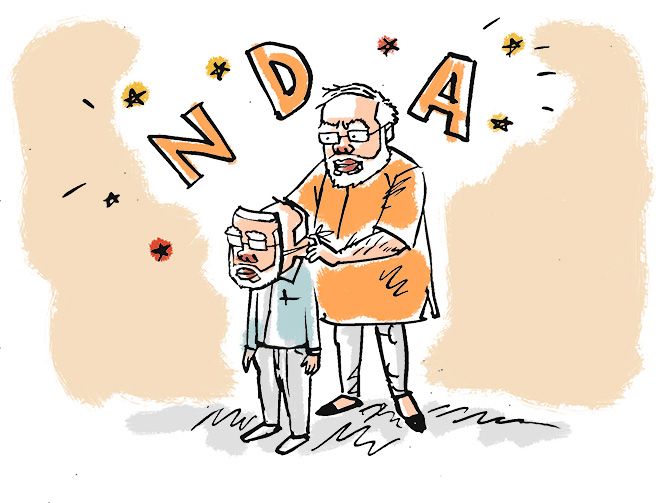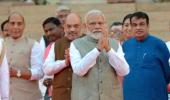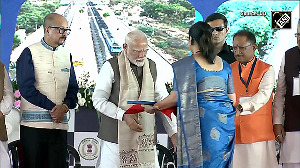'The AMs are a different beast and reflect the political play within the government.'
'Prime Minister Modi does not need to assuage any interest group to take the final call on any decision that belongs rightfully to the Cabinet,' points out Subhomoy Bhattacharjee.
Illustration: Dominic Xavier/Rediff.com

That the National Democratic Alliance under Prime Minister Narendra Damodardas Modi has created an abundant number of group of ministers in its six years at Raisina Hill is hardly news.
The surprise is that those GoMs tasked with specific roles such as divestment or telecom revival play only a supervisory role and rarely make the executive decisions.
This is where these teams of ministers differ from those set up during the two terms of the United Progressive Alliance.
The Modi government has used a different moniker for GoMs, primarily because they had become synonymous with delays in decision-making.
They are now called alternative mechanisms (AMs), and there are fewer of them than during the UPA regime.
When then prime minister Manmohan Singh left office, there were nine empowered group of ministers (EGoMs) and 21 group of ministers in operation.
To date, the NDA government in its two terms has set up eight of them.
In a significant departure in their style of functioning from the UPA regime, the AMs mostly do not wield any executive authority to approve a decision.
Instead, they inspect the decisions made by departmental secretaries and their team of officers on the specific issue they have been tasked to do.
Once they are satisfied, those decisions travel to the Cabinet, which gives its formal approval.
The Cabinet Committee on Economic Affairs, for example, has approved the creation of two AMs in March 2019, to supervise the strategic disinvestment of central public sector enterprises.
The AMs have come into being after the CCEA has already given an 'in principle' approval for divestments.
The AMs remain subservient to the CCEA and will look into:
i. 'The quantum of shares to be transacted, mode of sale and final pricing of the transaction or lay down the principles/ guidelines for such pricing; and the selection of strategic partner/buyer' and so on
ii. To decide on the proposals of divestment 'with regard to the timing, price, the terms and conditions of sale' and related issues.
As a government release notes, the approval by the AMs means the decisions should be faster.
'This will facilitate quick decision-making and obviate the need for multiple instances of approval by the CCEA for the same (company)'.
Under the UPA, the EGoMs had the right to act as a Cabinet and issue orders accordingly.
The GoMs operated one rung below them and had to send their decisions to the Cabinet.
For instance, the EGoM on food security was set up to 'consider issues concerning procurement, management of food-grains stocks, revision of central issue prices of food-grains and the proposed law on food security'.
It operated like a Cabinet with a wide ranging mandate co-terminus with the term of the government and with its own bureaucracy.
No NDA GoM has such a sweeping mandate.
The nearest is a GoM to prepare a blueprint for the development in Jammu and Kashmir.
Instead, GoMs are meant to answer specific questions like the one set up under Home Minister Amit Anilchandra Shah to work out the details of the government's major scheme to provide piped drinking water to every household.
One of its deliverable is how to reinstate user charges for water.
Similarly, the home minister also heads a group to review amendments to the Land Registration Act and one on the revival of MTNL and BSNL.
In each case, the menu of options will be put forth by the secretaries concerned, and the decisions will be signed by them.
The ministers will only give their views on which among the alternatives should be adopted as the most feasible option.
The UPA government GoMs, almost without fail, signed on to the decisions.
Is it a necessity for ministers to sign on to the decisions made by them in the groups? Frankly, it depends on the constitution of the government of the day.
The standard rule applies only to the various cabinet committees set up by each government once it assumes office after a general election.
These formed under the 'Transaction of Business Rules' are the Appointments Committee, Committee on Accommodation, Cabinet Committee on Economic Affairs, Cabinet Committee on Parliamentary Affairs, Cabinet Committee on Political Affairs, Cabinet Committee on Security, Cabinet Committee on Investment and Growth and Cabinet Committee on Employment and Skill Development.
Their number too is a political call but once formed, they are usually exist co-terminus with the term of the government in power.
The GoMs or the AMs are a different beast and reflect the political play within the government.
The reasons for the plethora of GoMs under Dr Singh was the need to give every political party in the coalition a space under the sun.
Prime Minister Modi does not need to assuage any interest group to take the final call on any decision that belongs rightfully to the Cabinet.
Compared to the AMs or GoMs that bring together only the central ministers, the groups which bring together the state ministers with central ministers have a more organised feel to them.
This includes the GST Council, formed under the GST Acts.
Here even the sub-committees issue formal reports, like the GoM -- for example, to suggest ways to resolve the crisis facing the real estate sector following the roll out of the GST.
This GoM is headed Gujarat Deputy Chief Minister Nitin Patel and includes the finance ministers of Kerala, Punjab, Karnataka, Maharashtra and Uttar Pradesh and Goa's panchayat minister as members.
Then, there is the one to examine the best practices in road safety and road transport sector, which is tasked with drawing up an actionable plan for implementation.












 © 2025
© 2025